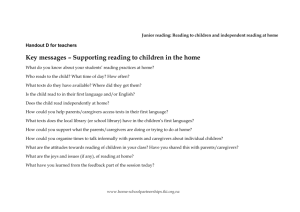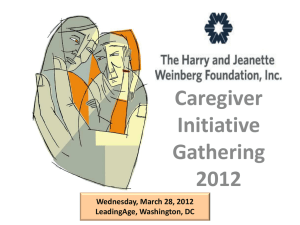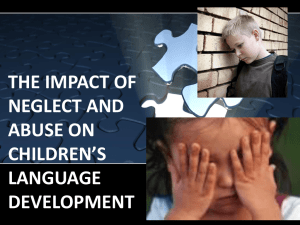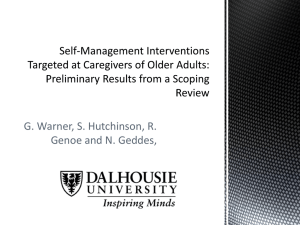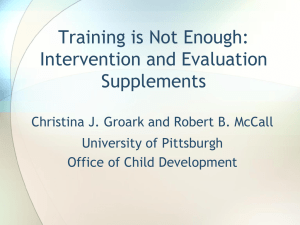Terms of Reference for Impact Evaluations
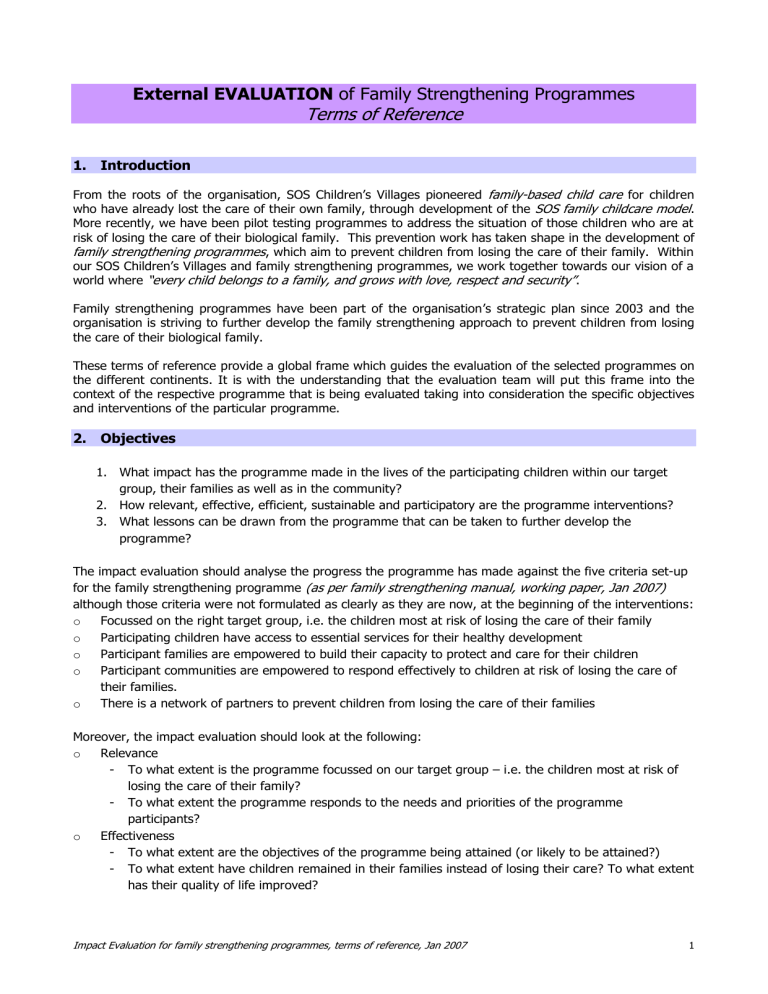
External EVALUATION of Family Strengthening Programmes
Terms of Reference
1.
Introduction
From the roots of the organisation, SOS Children’s Villages pioneered
family-based child care
who have already lost the care of their own family, through development of the
for children
SOS family childcare model
.
More recently, we have been pilot testing programmes to address the situation of those children who are at risk of losing the care of their biological family. This prevention work has taken shape in the development of
family strengthening programmes
, which aim to prevent children from losing the care of their family. Within our SOS Children’s Villages and family strengthening programmes, we work together towards our vision of a world where
“every child belongs to a family, and grows with love, respect and security”
.
Family strengthening programmes have been part of the organisation’s strategic plan since 2003 and the organisation is striving to further develop the family strengthening approach to prevent children from losing the care of their biological family.
These terms of reference provide a global frame which guides the evaluation of the selected programmes on the different continents. It is with the understanding that the evaluation team will put this frame into the context of the respective programme that is being evaluated taking into consideration the specific objectives and interventions of the particular programme.
2.
Objectives
1.
What impact has the programme made in the lives of the participating children within our target group, their families as well as in the community?
2.
How relevant, effective, efficient, sustainable and participatory are the programme interventions?
3.
What lessons can be drawn from the programme that can be taken to further develop the programme?
The impact evaluation should analyse the progress the programme has made against the five criteria set-up for the family strengthening programme
(as per family strengthening manual, working paper, Jan 2007)
although those criteria were not formulated as clearly as they are now, at the beginning of the interventions: o Focussed on the right target group, i.e. the children most at risk of losing the care of their family o Participating children have access to essential services for their healthy development o Participant families are empowered to build their capacity to protect and care for their children o Participant communities are empowered to respond effectively to children at risk of losing the care of their families. o There is a network of partners to prevent children from losing the care of their families
Moreover, the impact evaluation should look at the following: o Relevance
To what extent is the programme focussed on our target group – i.e. the children most at risk of losing the care of their family?
To what extent the programme responds to the needs and priorities of the programme participants? o Effectiveness
To what extent are the objectives of the programme being attained (or likely to be attained?)
To what extent have children remained in their families instead of losing their care? To what extent has their quality of life improved?
Impact Evaluation for family strengthening programmes, terms of reference, Jan 2007 1
To what extent have families successfully left the programme since the beginning, i.e. became selfreliant? How many children and families have been reached over the whole programme period? o Efficiency
Is the relation between input of resources and results achieved appropriate and justifiable (costbenefit ratio)? What are the annual running costs and the average costs per child per month?
Have individual resources been used most economically? (e.g. tenders for the purchase of goods)
Are there any alternatives for reaching the same result with less input? o Sustainability
To what extent can activities, results and effects be expected to continue after SOS involvement has ended?
Is there progress towards SOS withdrawing from its direct involvement and handing over the full responsibility to run the programme to an implementation partner?
Has the capacity of the implementation partner been developed? If so, in what areas and how? o Participation
To what extent are stakeholders (participant families (including children), partners, local authority) involved in the design, planning and implementation of the programme?
To what extent is the programme designed to develop the necessary local institutional
(governmental and/or non-governmental) capacity to respond to the problem?
3.
Key areas
Within the family strengthening programme, children, families, and communities have been supported in various areas, which this impact assessment exercise should look at. However, this is with the understanding that different programmes provide different kind of services. Therefore, the evaluation team needs to decide in cooperation with the programme team which of the below mentioned areas apply to the particular programme. However, section A, which looks at the definition of the target group as well as the selection process of participating families should apply everywhere.
A.
Target group
How the target group has been defined
How participant families are identified, verified and selected (criteria and process)
B.
Nutritional support
Number of children and caregivers receiving the support – if possible in proportion
(number should be proportionate to the total of those who have been identified as needing such support)
Type and appropriateness of nutritional support provided for children by the programme directly or through referral (i.e. food package, food vouchers); identify the impact and if there is something to be added, reduced or removed.
Any other support caregivers get from the programme with regard to nutrition of their children (e.g. cooking lessons)
Type of meals (composition), quantity, and frequency per day
How long families receive food support; is food support gradually reduced or are there signs of dependency?
If caregivers and/or programme staff feel that children have weight/height according to age; any symptoms of malnutrition observed by mothers and/or programme staff; find out the reasons.
Level of satisfaction of children and caregivers regarding this support
C.
Health support
Impact Evaluation for family strengthening programmes, terms of reference, Jan 2007 2
D.
Number of children and caregivers receiving the support – if possible in proportion
(number should be proportionate to the total of those who have been identified as needing such support
Type and appropriateness of health support provided to children and/or care givers by the programme directly or through referral; any health education provided; identify the impact and if there is something to be added, reduced or removed.
Access to medical care by children and care givers; Frequency of health checks for children as well as for caregivers; constraints for visiting and undertaking regular health check-ups for children and caregivers;
Capacity of the program to respond to medical problems commonly experienced by the target group
(e.g. related to HIV/AIDS, tuberculosis, drug addiction)
How the health conditions of children and caregivers in the programme are; did they improve, decrease or remain the same since they joined the programme?
What difference this support has made in the participants’ lives
Level of satisfaction of children and caregivers regarding this support
Educational support
Number of children supported to access formal basic (primary and secondary) education as well as informal education – if possible in proportion
(number should be proportionate to the total of those who have been identified as needing such support)
Type and appropriateness of educational support provided to children by the programme directly or through referral; identify the impact and there is something to be added, reduced or removed.
How is the track record concerning children’s attendance, as well as staying enrolled in the educational system
Level of educational performance of children against their past performance and against national standards/averages (explain the parameters used for evaluating this)
Level of satisfaction of caregivers and children regarding this support
E.
Psychosocial support
Number of children and caregivers being supported to access counselling services – if possible in proportion
(number should be proportionate to the total of those who have been identified as needing such support)
Type and appropriateness of psycho-social support provided to children and/or care givers by the programme directly or through referral; identify the impact and if there is something to be added, reduced or removed.
How children and caregivers have been effectively supported to address relevant issues
Participation of children in seminars/workshops on life skills (if possible provide their number and frequency and type of participation)
How the programme staff /SOS village and other external specialists view children’s psychological development – (if possible provide number of children who have improved in their psychosocial development after the intervention)
Attendance level of children and caregivers to counselling sessions and the impact of counselling
Frequency of family home visits by the programme
Participation of caregivers in community life
Number of caregivers who have recovered from drug and alcohol addiction
Level of satisfaction of children and caregivers regarding this support
F.
Living conditions
Number of families/children supported in shelter and other items related to child’s living conditions
Impact Evaluation for family strengthening programmes, terms of reference, Jan 2007 3
G.
H.
Promotion of child rights/parenting skills
Number of children and caregivers taking part in education workshops in child development and child rights
Type and appropriateness of activities provided to children and/or caregivers by the programme directly or through referral; identify the impact and if there is something to be added, reduced or removed.
To what extent children, caregivers and communities have knowledge on children’s rights
Any example where children have started to exercise their rights
If caregivers have improved their parental skills (provide specific information on the parameters used for improved parental skills)
Any changes or improvements in parent and child relationship and child care practices (if possible provide number of cases known)
Legal support
Type and appropriateness of activities provided by the programme directly or through referral; identify the impact and if there is something to be added, reduced or removed.
Number of families who have got the necessary legal documents, and indicate the documents obtained.
Number of families who have secured their property and assets through proper documentation (e.g. wills, ownership documents)
I.
Type and appropriateness of support provided by the programme directly or through referral (e.g. shelter, clothes, blankets); identify the impact and if there is something to be added, reduced or removed.
How safe families’ living conditions are, and how they feel about it
Are living conditions adequate relative to acceptable local standards? (relates to such things as number of rooms, especially sleeping rooms; size of house; sanitation; source of light and heat; water supply, etc.)
Level of satisfaction of caregivers and children regarding this support
Economic support
Type and appropriateness of economic support provided by the programme directly or through referral (e.g. skills training, income generation activities, debt payment, short term cash support; referral to employment service); identify the impact and if there is something to be added, reduced or removed.
The extent to which this support has changed the lives of families; caregivers have jobs or other income generation activities providing “stable” and “sufficient” income
Role of economic support in reducing dependency, stress and building confidence; Appropriateness of the economic support responding to the needs and expectations of participants
If loans are provided, how much and at what rate, and to what extent repayment system is working
J.
Family Development Planning
Number of families who have a family development plan
(in proportion to the total number of participating families)
To what extent families take responsibility (ownership) in realising the goals set in FDP
What constraints they encounter to take such responsibility
General improvement in life planning
Level of satisfaction of caregivers and children regarding the FDP process
Number of families who have exited the programme – broken down into how many families successfully achieved goals in their FDP; how many were dropped from the programme due to lack
Impact Evaluation for family strengthening programmes, terms of reference, Jan 2007 4
M.
of commitment; and how many simply moved out of the programme for other reasons, e.g. move house.
K.
Community based structures
Type of community based structures and activities the programme collaborates with
Type and number of community structures and activities established with the support of the programme to support families to prevent child abandonment
Kind and number of community based structures or activities which existed (e.g. family committees, community groups, self help groups, volunteer groups), but have been strengthened by the programme (specify the type of capacity building work carried out)
Type and number of community based implementation partners, and what interventions they carry out.
Is the capacity of community structures build in a way that leads to sustainability? Is it foreseeable that families will be supported by community structures without SOS involvement?
Satisfaction level by the families of the services provided to them by community based structures
Number of families entering & existing the programme (turn-over rate)
L.
Other partners
Type and number of other local implementation partners (e.g. local government, local NGOs, international NGOs)
Is the capacity of the implementation partner strengthened in a way that is sustainable? Is it foreseeable that families will be supported by partners also without SOS involvement?
Type of partnerships with other service providers with whom the programme collaborates; type of services they each provide
Kind and number of local organisations that have their capacity strengthened through the programme; in what way
The trend in number of families supported by other service providers collaborating with the programme (number in the increase or decrease)
Satisfaction level by the participants/clients of the quality of services provided
Management / administration systems
How well the programme is structured and staff is supervised
To what extent the programme is supported by an appropriate management, monitoring and evaluation system? Is this system geared towards sustainability (with takeover of implementation partner in mind)?
N.
Human resources
Adequate human resources in programme? If not, where/how?
Relationship between staff members and team work
Relationship between staff and implementation partner (including volunteers)
Training of staff and volunteers
Any training needs?
Clear division of roles and responsibilities between the staff and between SOS and its partners
4.
Methodology
o As a minimum requirement, this evaluation exercise looks at the changes that have happened in participating family’s lives due to their participation in the programme. At this stage, it is not a
Impact Evaluation for family strengthening programmes, terms of reference, Jan 2007 5
requirement to work with a control group and we are aware of the fact, that therefore the external factors that impact on family’s lives are only marginally considered. o As this impact evaluation is an opportunity for learning for the programme staff, it is critical that the programme staff participates throughout the evaluation process. o The evaluation should use quantitative (e.g. surveys) and qualitative data collection methods such as semi-structured interviews (for example with focus groups, key informant, large groups, individual interviews, etc.) as necessary. o As the evaluation criteria as well as the indicators were not developed before the start of the programme, it is not expected to go into depth to seek information on the quantitative aspects of the programme, hence the qualitative information should be the major focus at this stage. However, if quantitative data has been collected by the programme and it is related to the evaluation criteria
(objectives), they should be analysed. o The evaluation should use participatory methodologies to involve programme participants (families currently on the programme as well as families that have already exited the programme) and wherever possible children should be involved in the design and implementation of the impact assessment. It is suggested to group programme participants in the evaluation based on their length of participation in the programme.
5.
Major Tasks
Lead the impact evaluation exercise involving the project staff and other key stakeholders, including: o Plan the evaluation design in coordination with programme staff o Review the project documentation and other sources of information o Undertake a SWOT exercise with programme staff o Plan, design, and coordinate the data collection process
Identification of the major stakeholders who are associated with the programme to be interviewed, such as the direct participants of the programme (children, care-givers) implementation partners, key local government representatives, and other service providers
-
Composition of a survey team
Selection of representative sample of communities or groups to be interviewed on the basis of agreed criteria
Agreeing on the type of information to be collected
-
-
Preparation of checklists and other tools for data collection
Facilitate learning during the data collection exercise o Collection of data o Analysis of the data o Preparation of a draft report and finalisation after inputs from various stakeholders o Present the findings to the programme staff o After having received feedback from the various stakeholders – finalise the report
Impact Evaluation for family strengthening programmes, terms of reference, Jan 2007 6
6.
Output
The final impact evaluation shall be a written report following the proposed outline:
Title page
Name of the programme, country, date, implementing agency of the evaluation, name of the authors
Summary of conclusions and recommendations
Executive summary (4-6 pages)
1.
Introduction
1.1.
Description of the objectives of the evaluation
1.2.
Short description of the overall evaluation process, the evaluation team and methodologies applied
2.
Programme description
2.1.
Short description of the programme (location, history + current status, duration, beneficiaries/participants, budget)
2.2.
Description of the programme’s overall objectives, activities and expected results after programme
2.3.
implementation
Short description of the applied planning, monitoring and evaluation processes for programme implementation
2.4.
Short description of the management structure of the programme
2.5.
Overview of the human resource allocations/staffing patterns of the programme and its implementation partners
2.6.
Statement of the guiding documents that influenced the development of the programme (internal and external)
3.
Evaluation results
3.1.
The programme is focussed on the right target group
3.2.
Participating children have access to essential services for their healthy development
3.3.
Participant families are empowered to build their capacity to protect and care for their children
3.4.
Participant communities are empowered to respond effectively to children at risk of losing the care of their families
3.5.
There is a network of partners to prevent children from losing the care of their families
3.6.
Relevance
3.7.
Effectiveness
3.8.
Efficiency
3.9.
Sustainability
3.10.
Participation
4.
Lessons learnt, Conclusions and Recommendations
4.1.
Operational lessons learnt
4.2.
Conclusions
4.3.
Recommendations for further action – identify components of the programme that have great potential for further development, but also interventions that need to change radically or even phase out.
Impact Evaluation for family strengthening programmes, terms of reference, Jan 2007 7
